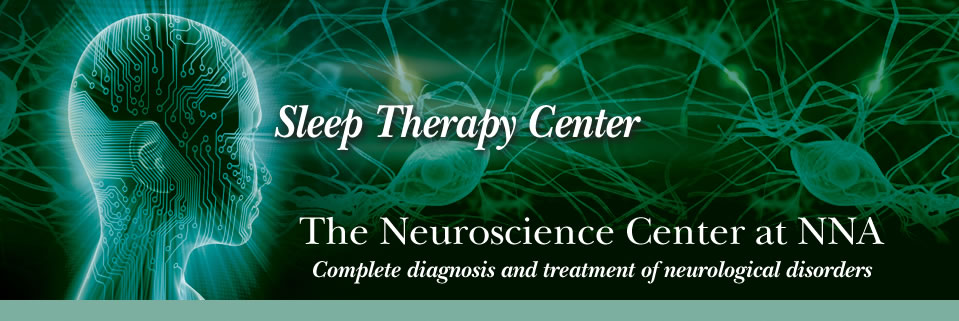
Sleep Therapy Center
The Sleep Therapy Center is dedicated to assuring each patient gets a healthy night's sleep. Registered respiratory therapists work hand-in-hand with the physicians and the patients to ensure optimal sleep therapy modalities. We provide state-of-the-art sleep therapy equipment set-up, maintenance of supplies and a comprehensive follow-up program.
Obstructive sleep apnea is a common disorder affecting 5% of adult men and 3% of adult women according to recent studies. OSA has been associated with an increased risk of hypertension, heart failure, stroke, atrial fibrillation, type 2 diabetes, and other conditions including death. Apnea is interrupted breathing during sleep. It usually occurs because of a mechanical problem in the airway, but it also can indicate a neurological disorder involving nerve cells (neurons). Obstructive sleep apnea is the most common type of sleep apnea and is caused by obstruction of the upper airway. It may appear that the person is gasping or snorting while sleeping. It is characterized by repetitive pauses in breathing during sleep, despite the effort to breathe, and is often associated with a reduction in blood oxygen levels. The pauses in breathing are called apneas that typically last 10-40 seconds.
The individual with OSA is rarely aware of having difficulty breathing, even upon awakening. It is normally recognized as a problem by a sleep partner witnessing loud snoring and actual episodes of cessation of breathing often followed by a gasp for air.
Signs and Symptoms
Symptoms may be present for years, even decades without identification. Common signs of OSA may include excessive daytime sleepiness, restless sleep, and loud snoring. Less common symptoms may include morning headaches, trouble concentrating, anxiety, depression, increased urination at night, increased heart rate and/or blood pressure; frequent heartburn and heavy night sweats. There is growing evidence that early screening and treatment may help prevent serious complications associated with untreated OSA.
Diagnosis
The diagnosis of sleep apnea is based on overnight polysomnography, (sleep study), where the number of apneas and changes in oxygen levels during sleep is monitored and documented. The results are read by a board certified sleep physician and a diagnosis is determined. Your physician will order the appropriate therapy at that time.
Treatment
There are several treatment options available for treating sleep apnea depending on the nature of the disorder. The most common and most effective method of treatment is Continuous Positive Airway Pressure (CPAP) therapy. A CPAP device is a flow generator that provides a gentle, pressurized, continuous airflow to maintain a positive pressure within the airway. This pressurized airflow acts to “splint” the airway open thus preventing obstruction during sleep. The CPAP unit is set at the pressure determined to be therapeutically appropriate based on the results of the polysomnography (overnight sleep study).
Bi-level therapy is an additional option your physician may order. In bilevel therapy there are two levels of pressure set. The first pressure will be set to be delivered during inhalation and a second lower pressure will be set to be delivered during exhalation. These devices are designed and sometimes prescribed for patients who have difficulty tolerating the constant pressure maintained with a CPAP device.
PAP devices are equipped with various features to help you more easily tolerate therapy and be comfortable.
Humidifiers
A heated humidifier can be used with the PAP unit to add humidity to the airflow being delivered to the airway. Heated humidifiers consist of a water reservoir and a heater base. The heater base heats the water in the reservoir that produces moisture content which will be delivered airway. The humidified airflow will help soothe the airway and reduce dryness. The patient can control the heater setting, thus controlling the amount of desired humidity within the system.
Ramp Feature
PAP devices are equipped with a ramp feature that allows the beginning pressure to be lowered for a desired amount of time. Using the ramp will allow you to fall asleep with the unit at a lower pressure. Over a set time the pressure will gradually increase to your prescribed level of pressure. You may adjust the amount of time you choose to be in the ramp mode.
Pressure Relief Technology
PAP devices offer another comfort feature that makes it easier to exhale against the positive pressure generated by the unit. The pressure relief level can be adjusted. Your therapist will discuss this feature with you and help you decide where to start.
At the NNA Sleep Therapy Center we specialize in the treatment of sleep disorders coordinating care with your physician. We work one on one with the patient to monitor progress, resolve issues that may arise, and continue follow up with our comprehensive follow up program.
If you are currently on therapy or are preparing to start therapy and have questions, please feel free to call us. We can schedule a visit with one of our registered respiratory therapists to answer your questions, evaluate your equipment and allow you an opportunity to view new options in therapy delivery interfaces.
We offer a wide variety of therapy delivery interfaces and state of the art positive pressure therapy delivery devices.To view these devices and interfaces online please visit:
Fisher Paykel Healthcare
If you are in need of supplies or wish to enroll in our supply replacement program you may contact our patient care coordinator Monday-Friday, 8am-4pm.
Kathy Galik, Patient Care Coordinator 330-572-1011 ex. 178